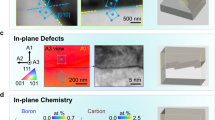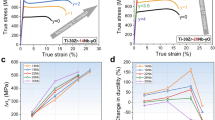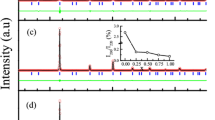Abstract
Collective interstitial ordering is at the core of martensite formation in Fe–C-based alloys, laying the foundation for high-strength steels. Even though this ordering has been studied extensively for more than a century, some fundamental mechanisms remain elusive. Here, we show the unexpected effects of two correlated phenomena on the ordering mechanism: anharmonicity and segregation. The local anharmonicity in the strain fields induced by interstitials substantially reduces the critical concentration for interstitial ordering, up to a factor of three. Further, the competition between interstitial ordering and segregation results in an effective decrease of interstitial segregation into extended defects for high interstitial concentrations. The mechanism and corresponding impact on interstitial ordering identified here enrich the theory of phase transitions in materials and constitute a crucial step in the design of ultra-high-performance alloys.
This is a preview of subscription content, access via your institution
Access options
Access Nature and 54 other Nature Portfolio journals
Get Nature+, our best-value online-access subscription
$29.99 / 30 days
cancel any time
Subscribe to this journal
Receive 12 print issues and online access
$259.00 per year
only $21.58 per issue
Buy this article
- Purchase on Springer Link
- Instant access to full article PDF
Prices may be subject to local taxes which are calculated during checkout





Similar content being viewed by others
Data availability
The datasets generated during the current study are available from the corresponding authors on request.
Code availability
The computer code developed during the current study is available from the corresponding authors on request.
References
Wuttig, M. et al. The role of vacancies and local distortions in the design of new phase-change materials. Nat. Mater. 6, 122–128 (2007).
Guignard, M. et al. P2-NaxVO2 system as electrodes for batteries and electron-correlated materials. Nat. Mater. 12, 74–80 (2013).
Sohn, S. S. et al. Ultrastrong medium-entropy single-phase alloys designed via severe lattice distortion. Adv. Mater. 31, 1807142 (2019).
Siegrist, T. et al. Disorder-induced localization in crystalline phase-change materials. Nat. Mater. 10, 202–208 (2011).
Li, X. et al. Direct visualization of the Jahn–Teller effect coupled to Na ordering in Na5/8MnO2. Nat. Mater. 13, 586–592 (2014).
Ni, Y. & Khachaturyan, A. G. From chessboard tweed to chessboard nanowire structure during pseudospinodal decomposition. Nat. Mater. 8, 410–414 (2009).
Lei, Z. et al. Enhanced strength and ductility in a high-entropy alloy via ordered oxygen complexes. Nature 563, 546–550 (2018).
Seljakow, N. The nature of martensite. Nature 123, 204–205 (1929).
Jack, K. H. Iron-nitrogen, iron-carbon and iron-carbon-nitrogen interstitial alloys: their occurrence in tempered martensite. Nature 158, 60–61 (1946).
Li, Y. et al. Segregation stabilizes nanocrystalline bulk steel with near theoretical strength. Phys. Rev. Lett. 113, 106104 (2014).
Zhang, X. et al. Structural transformations among austenite, ferrite and cementite in Fe-C alloys: a unified theory based on ab initio simulations. Acta Mater. 99, 281–289 (2015).
Wang, H., Zhang, X., Yan, D., Somsen, C. & Eggeler, G. Interface dominated cooperative nanoprecipitation in interstitial alloys. Nat. Commun. 9, 4107 (2018).
Zhang, X., Hickel, T., Rogal, J. & Neugebauer, J. Interplay between interstitial displacement and displacive lattice transformations. Phys. Rev. B 94, 104109 (2016).
Honda, K. & Sekito, S. Two kinds of martensite. Nature 121, 744 (1928).
Udyansky, A., von Pezold, J., Bugaev, V. N., Friák, M. & Neugebauer, J. Interplay between long-range elastic and short-range chemical interactions in Fe-C martensite formation. Phys. Rev. B 79, 224112 (2009).
Udyansky, A., von Pezold, J., Dick, A. & Neugebauer, J. Orientational ordering of interstitial atoms and martensite formation in dilute Fe-based solid solutions. Phys. Rev. B 83, 184112 (2011).
Naraghi, R., Selleby, M. & Ågren, J. Thermodynamics of stable and metastable structures in Fe-C system. Calphad 46, 148–158 (2014).
Ruban, A. V. Self-trapping of carbon atoms in α-Fe during the martensitic transformation: a qualitative picture from ab initio calculations. Phys. Rev. B 90, 144106 (2014).
Djaziri, S. et al. Deformation-induced martensite: a new paradigm for exceptional steels. Adv. Mater. 28, 7753–7757 (2016).
Khachaturian, A. Theory of Structural Transformations in Solids (Wiley, 1983).
Kanzaki, H. Point defects in face-centred cubic lattice-II X-ray scattering effects. J. Phys. Chem. Solids 2, 107–114 (1957).
Kanzaki, H. Point defects in face-centred cubic lattice-I Distortion around defects. J. Phys. Chem. Solids 2, 24–36 (1957).
Lau, T. T. et al. Many-body potential for point defect clusters in Fe-C alloys. Phys. Rev. Lett. 98, 215501 (2007).
Cochardt, A., Schoek, G. & Wiedersich, H. Interaction between dislocations and interstitial atoms in body-centered cubic metals. Acta Metall. 3, 533–537 (1955).
Kamber, K., Keefer, D. & Wert, C. Interactions of interstitials with dislocations in iron. Acta Metall. 9, 403–414 (1961).
Douthwaite, R. & Evans, J. Interaction between a tetragonal distortion and a 〈111〉 screw dislocation in an anisotropic cubic crystal. Scr. Mater. 7, 1019–1026 (1973).
de Hosson, J. An atomic model for the interaction between a 12 〈111〉 {110} edge dislocation and carbon in α-Fe. Solid State Commun. 17, 747–750 (1975).
Tapasa, K., Osetsky, Y. & Bacon, D. Computer simulation of interaction of an edge dislocation with a carbon interstitial in α-iron and effects on glide. Acta Mater. 55, 93–104 (2007).
Clouet, E., Garruchet, S., Nguyen, H., Perez, M. & Becquart, C. S. Dislocation interaction with C in α-Fe: a comparison between atomic simulations and elasticity theory. Acta Mater. 56, 3450–3460 (2008).
Lejček, P. Grain Boundary Segregation in Metals (Springer Berlin Heidelberg, 2010).
Speich, G. R. Tempering of low-carbon martensite. Trans. TMS-AIME 245, 2553–2564 (1969).
Wilde, J., Cerezo, A. & Smith, G. D. W. Three-dimensional atomic-scale mapping of a cottrell atomosphere around a dislocation in iron. Scr. Mater. 43, 39–48 (2000).
Fink, W. L. & Campbell, E. D. Influence of heat treatment and carbon contents on the structure of pure iron-carbon alloys. Trans. Am. Soc. Steel Treat. 9, 717–748 (1926).
Bain, E. C. & Paxton, H. W. Alloying Elements in Steel (ASM, 1966).
Honda, E. & Nishiyama, Z. On the nature of the tetragonal and cubic martensites. Sci. Rep. Toh. Imper. Univ. 21, 299–331 (1932).
Hägg, G. X-ray investigations on the structure and decomposition of martensite. J. Iron Steel Inst. 130, 439–451 (1934).
Xiao, L. et al. Lattice-parameter variation with carbon content of martensite. I. X-ray-diffraction experimental study. Phys. Rev. B 52, 9970–9978 (1995).
Krakauer, B. W. & Seidman, D. N. Absolute atomic-scale measurements of the Gibbsian interfacial excess of solute at internal interfaces. Phys. Rev. B 48, 6724–6727 (1993).
Santodonato, L. J., Liaw, P. K., Unocic, R. R., Bei, H. & Morris, J. R. Predictive multiphase evolution in Al-containing high-entropy alloys. Nat. Commun. 9, 4520 (2018).
King, G. & Woodward, P. M. Cation ordering in perovskites. J. Mater. Chem. 20, 5785–5796 (2010).
Plimpton, S. Fast parallel algorithms for short-range molecular dynamics. J. Comput. Phys. 117, 1–19 (1995).
Boeck, S., Freysoldt, C., Dick, A., Ismer, L. & Neugebauer, J. The object-oriented DFT program library S/PHI/nX. Comput. Phys. Commun. 182, 543–554 (2011).
Kresse, G. & Furthmüller, J. Efficient iterative schemes for ab initio total-energy calculations using a plane-wave basis set. Phys. Rev. B 54, 11169–11186 (1996).
Blöchl, P. E. Projector augmented-wave method. Phys. Rev. B 50, 17953–17979 (1994).
Perdew, J. P., Burke, K. & Ernzerhof, M. Generalized gradient approximation made simple. Phys. Rev. Lett. 77, 3865–3868 (1996).
Monkhorst, H. J. & Pack, J. D. Special points for Brillouin-zone integrations. Phys. Rev. B 13, 5188–5192 (1976).
Uebing, C. On the ordering of interstitials in bcc metals and bct martensites: a lattice gas approach. Scr. Metall. Mater. 30, 1183–1188 (1994).
Finney, D. J. Bioassay and the practice of statistical inference. Int. Stat. Rev. 47, 1–12 (1979).
Acknowledgements
We gratefully acknowledge the financial support from the German Research Foundation (DFG) under grant HI 1300/15-1 within the DFG-ANR project C-TRAM. H.W. thanks J. Westraadt at the Nelson Mandela University for help with measuring the TEM foil thickness by EELS. X.Z. thanks W. Wang for fruitful discussions.
Author information
Authors and Affiliations
Contributions
X.Z., T.H. and J.N. designed the project. X.Z. performed all atomistic calculations under the supervision of T.H., J.R. and J.N. H.W. and Y.L. did the HRTEM characterization and APT analysis. All authors discussed the results and contributed to writing the manuscript.
Corresponding authors
Ethics declarations
Competing interests
The authors declare no competing interests.
Additional information
Publisher’s note Springer Nature remains neutral with regard to jurisdictional claims in published maps and institutional affiliations.
Supplementary information
Supplementary Information
Supplementary Notes 1–5, Figs. 1–10 and Table 1.
Rights and permissions
About this article
Cite this article
Zhang, X., Wang, H., Hickel, T. et al. Mechanism of collective interstitial ordering in Fe–C alloys. Nat. Mater. 19, 849–854 (2020). https://doi.org/10.1038/s41563-020-0677-9
Received:
Accepted:
Published:
Issue Date:
DOI: https://doi.org/10.1038/s41563-020-0677-9
This article is cited by
-
Thermodynamic Prediction of the Impact of Carbon on Bainite Formation, Including the BCT Transformation
Journal of Phase Equilibria and Diffusion (2023)



